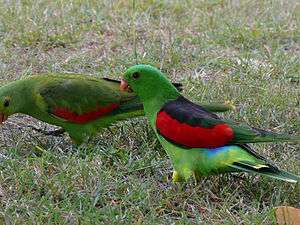Red-winged parrot
| Red-winged parrot | |
|---|---|
 | |
| A pair (female on left and male on right) | |
| Scientific classification | |
| Kingdom: | Animalia |
| Phylum: | Chordata |
| Class: | Aves |
| Order: | Psittaciformes |
| Superfamily: | Psittacoidea |
| Family: | Psittaculidae |
| Subfamily: | Psittaculinae |
| Tribe: | Polytelini |
| Genus: | Aprosmictus |
| Species: | A. erythropterus |
| Binomial name | |
| Aprosmictus erythropterus (Gmelin, 1788) | |
| | |
| Distribution of the red-winged parrot | |
The red-winged parrot (Aprosmictus erythropterus), is a parrot native to Australia and Papua New Guinea. It is found in grasslands, savannah, farmland, and woodland.
Taxonomy
German naturalist Johann Friedrich Gmelin described the species in 1788. The species names is derived from the Ancient Greek words erythros "red" and pteron "wing".
Alternative common names include crimson-winged parrot and blood-winged parrot.[2]
Subspecies
- Aprosmictus erythropterus erythropterus (Gmelin, 1788)
- Aprosmictus erythropterus coccineopterus (Gould,1865)
- Aprosmictus erythropterus papua (Mayr & Rand, 1936)
Description
The red-winged parrot is typically about 30 to 33 cm (12–13 in) in length. Both sexes have bright red wings and a bright green body. The male birds have a black nape, lower blue back and rump with a yellow tip on their tail, an orange bill and grey feet. The female birds have a yellowish-green body and the wings have red and pink trimmings. Also distinguishing the females are dark irises and the lower back is a light blue colour. Juveniles have orange/yellow beaks and pale brown irises, and otherwise resemble females in colouration. Males develop adult plumage at about the age of two years and females at the age of about a year and a half.
Distribution and habitat
Their range is from the Pilbara, Western Australia to Cape York Peninsula, Queensland (to be seen almost all over Queensland) and as south as northeast South Australia. They are occasionally spotted in Papua New Guinea. These birds inhabit riverine forests, forest edges, acacia scrub, savanna, mangroves, and farmlands. They are seen often in pairs or flocks near water.
Diet
Their diet typical consists of seeds from eucalyptus, acacia, berries, flowers, and insects. The birds' call are "ching-ching", "chink-chink" or thin screeching.
Breeding
 An immature male at Honolulu Zoo, Hawaii, USA.
An immature male at Honolulu Zoo, Hawaii, USA. Female at Adelaide Zoo, Australia
Female at Adelaide Zoo, Australia_-Brisbane_Zoo-6.jpg) Juvenile in an aviary
Juvenile in an aviary Carpet Springs, SW Queensland, Australia
Carpet Springs, SW Queensland, Australia
The birds typically breed in spring and summer, but breeding times depends on their location. A hollow space in a tree at a height of 11 m from the ground usually acts as nest for breeding . Generally, three to six white eggs are laid per season, the eggs being 31 mm in length. The female incubates while the male searches for food. The chicks stay with their parents for about five weeks. It has been hybridised with the Australian king parrot. The hybrid is fertile and breeds true to form.
References
- ↑ BirdLife International (2012). "Aprosmictus erythropterus". IUCN Red List of Threatened Species. Version 2013.2. International Union for Conservation of Nature. Retrieved 26 November 2013.
- ↑ Lendon, Alan H. (1973). Australian Parrots in Field and Aviary. Sydney, New South Wales: Angus & Robertson. p. 129. ISBN 0-207-12424-8.
- Pizzey and Knight, Field Guide to the Birds of Australia, Angus & Robertson, ISBN 0-207-19691-5
External links
| Wikimedia Commons has media related to Aprosmictus erythropterus. |
| Wikispecies has information related to: Aprosmictus erythropterus |
- Video of Red-winged Parrot from western Qld on YouTube
- World Parrot Trust Parrot Encyclopedia - Species Profiles
